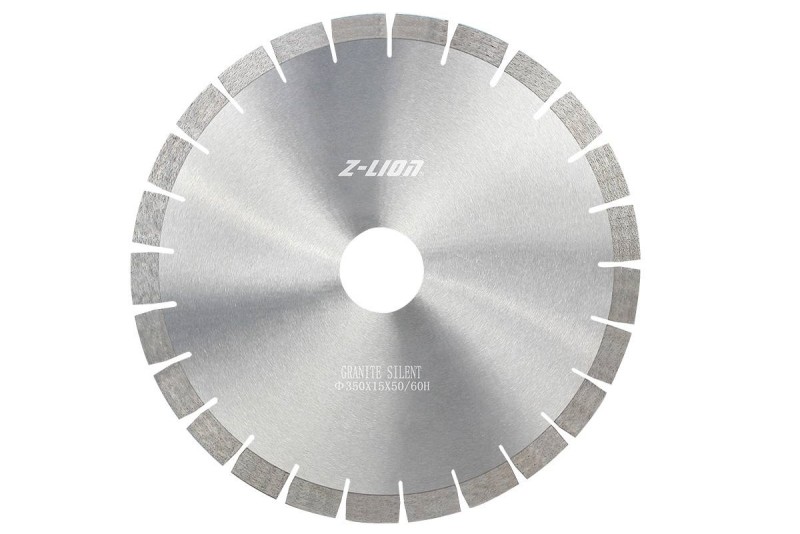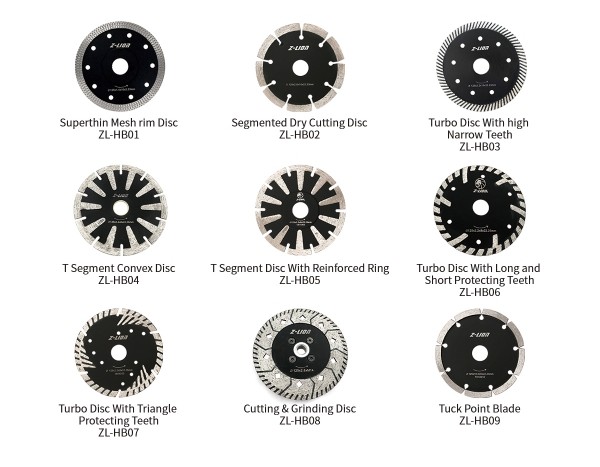
Different Types of Blades for the Construction Industry
In the construction industry, blade selection is essential for cutting various materials to achieve the best results. Since there are a wide variety of blades available in the market, it is essential to understand the different types of blades and their specific applications.
Saw Blade Types by Application

1. Granite blade:
Purpose: These blades are designed specifically for cutting granite and can handle the hardness and density of this material.
Features: Granite saw blades are typically diamond segmented for efficient cutting with minimal chipping. They come in a variety of styles, including continuous edge, segmented, and turbine blades, each suited to different cutting techniques and finishes.
Applications: Granite blades are commonly used for countertops, tiles, and architectural features and are essential for both rough cutting and precision work.
2. Marble blade:
Purpose: Similar to granite blades, marble blades are used to cut marble, which is softer than granite but still requires a specialized tool to make a clean cut.
Features: Marble saw blades are usually designed with a continuous edge to provide a smooth cut and reduce chipping. They may also have a higher diamond concentration for more efficient cutting.
Applications: Marble blades are used for floors, decorative elements and sculptures, ideal for achieving a polished effect.
3. Concrete blade:
Purpose: These blades are specifically designed for cutting concrete, which is very abrasive and hard.
Features: Concrete blades are usually designed in segments to allow for efficient material removal and cooling during the cutting process. They are available in both wet and dry cutting options.
Application: Commonly used in construction for cutting concrete slabs, walls and curbs.
4. Ceramic blade:
Intended: These blades are designed specifically for cutting ceramic tile and are built to handle the density and hardness of porcelain.
Features: Porcelain blades typically have fine emery grain and a continuous edge to ensure a clean cut without chipping.
Application: The porcelain knife is ideal for floor and wall tiles and is essential for achieving high-quality results.
5. Asphalt blade:
Purpose: These blades are specifically designed for cutting asphalt, which is softer than concrete but requires specialized tools to prevent damage.
Features: Asphalt blades are usually designed in segments for efficient cutting and cooling.
Application: Asphalt blades are used in road construction and repair and are essential for maintaining road surfaces.
6. Wooden blade:
Purpose: These blades are designed for cutting wood and can handle the different densities of different types of wood.
Features: Wood blades typically have fewer teeth and are designed to minimize chipping and tearing.
Application: Wood blades are commonly used in carpentry and joinery and are essential for achieving clean cuts in wood and plywood.
7. Glass blade:
Purpose: These blades are specifically designed for cutting glass, which requires precise cuts to avoid breakage.
Features: Glass blades usually have fine emery grains and smooth edges to ensure a clean cut.
Application: Glass blades are used in glazing and decorative glass applications and are essential to achieving a high quality finish.
Blade Type According to Diameter
1. Mini blade
Sizes: Mini blades range in diameter from 25mm to 75mm.
Use: These blades are primarily used for engraving and intricate cutting tasks. Their small size allows for precision work in tight spaces or on fine designs.
Mounting options: Mini inserts can be mounted using a tool holder or attached to a flange, such as M14 or 5/8”-11. This versatility makes them compatible with a wide range of tools, including rotary tools and small grinders.

2. Small size blade
Size: Small size blades typically have a diameter between 100 mm and 230 mm.
Uses: These blades are typically used with an angle grinder or table saw. They are suitable for a variety of materials including concrete, tile, and stone.
Center hole size: The center hole of small size inserts may vary, typically 18mm, 20mm, 22.23mm or 25.4mm in diameter. Adapters can be installed to fit different machines, increasing their versatility.
3. Medium blade
Sizes: Medium blades range in diameter from 230mm to 600mm, with the most popular sizes being 350mm, 400mm and 450mm.
Use: These blades are often used with bridge cutters which are designed for cutting larger slabs of stone or concrete. Their size allows for efficient cutting of thicker materials.
Centre hole size: Medium blades typically have a 60mm centre hole, but a ring adaptor can be fitted to accommodate a 50mm hole, making it suitable for a wide range of cutting machines.
4. Large size blade
Size: Large-sized blades can reach a diameter of 1.5 m, 2 m, or even 3 m.
Use: These blades are designed for cutting large materials such as huge stones, concrete slabs or other large building materials. Their size and strength make them ideal for heavy-duty applications in construction and quarries.
Application: Large size blades are often used in industrial settings including stone processing workshops and large construction sites where efficiency and power are critical.
Blade Types by Technology
1. Cold pressed blades
Manufacturing process: Cold pressed blades are produced at room temperature using a press. Diamond particles are mixed with a binder and then pressed into shape without heating.
Cost: These blades are generally cheaper due to the simpler manufacturing process.
Application: Cold pressed blades are suitable for less demanding applications where cost effectiveness is the primary consideration. They are often used for general cutting tasks but may not have the same durability as other types of blades.
2. Hot pressing blade
Manufacturing process: Hot-pressed blades are made using high temperature and high pressure. Diamond particles fuse with the bonding material under heated pressure, creating a stronger bond.
Size: Typically, the size of a hot press blade is less than 300 mm.
Cost: The manufacturing process is more complicated and the cost is higher compared to cold pressed blades.
Advantages: Heat pressed blades generally have better lifespan and quality, making them suitable for applications that require greater durability.
3. Welding blade
Manufacturing process: In a welded blade, the diamond tip is welded to a metal base. This can be done using different welding techniques, including silver welding and laser welding.
Size: The diameter of welding blades is usually greater than 300 mm.
Benefits: Laser welding provides greater precision and stronger bonds, resulting in improved performance and lifespan. Welded blades are ideal for heavy-duty applications such as cutting stone or concrete.
4. Electroplated blades
Manufacturing process: Electroplated blades are made by electroplating diamond particles onto the surface or edge of a metal substrate. The process involves depositing a layer of diamond through an electrochemical reaction.
Benefits: Electroplated blades have very sharp edges and are often used for precision cutting tasks. They are particularly effective on materials that require a fine surface finish, such as glass or ceramics.
Application: These blades are typically used in applications where precision and clean cuts are critical.
5. Brazing blades
Manufacturing process: Brazed inserts are made using a vacuum brazing process that firmly implants the diamond tip onto a substrate. This method involves heating the tip and bonding material in a vacuum environment to form a strong bond.
Benefits: Brazed blades hold the diamond bits securely, improving durability and performance. They are less likely to lose bits during use, making them suitable for heavy-duty applications.
Application: Brazed blades are commonly used in construction and stone cutting, where reliability and performance are critical.
By Function
Cutting blade: Mainly used for cutting various materials.
Grooving blades: Used to create grooves, thickness options include 8mm, 10mm or 12mm and V-segments, typically sized 100mm or 125mm.
Cutting and grinding blades: Have a larger cutting and grinding working area, typically measuring 5 inches.
Engraving blades: Small blades (25 mm to 75 mm) designed specifically for engraving tasks.
According to Purpose
Wet blades: Used with water cooling to prevent overheating during cutting, most blades are designed for wet use.
Dry blades: These blades are designed for dry cutting without water, which will create dust, so protective gear is required.
Core
The core design of the blade affects its noise level and performance:
Regular blades: Made with a standard matrix, these blades may produce noise during use.
Quiet blades: With a silent matrix construction, these blades run quietly and are more environmentally friendly, although they tend to be more expensive.
Central Hole
The design of the center hole may vary, affecting compatibility with the cutting machine:
Round center hole: Common sizes include 18mm, 20mm, 22.23mm, 25.4mm, 50mm, and 60mm.
Triangle hole: These blades are designed for specific machines and have a triangular hole in the center.
Center and position holes: Some blades have a center hole as well as one, two, or even three position holes for added versatility.
-
Online service
-
Official wechat
account
-
QQ:40933769
-
E-mail:
sales@z-lion.com
Online service
Please feel free to give your inquiry in the form below. We will reply you in 24 hours.

